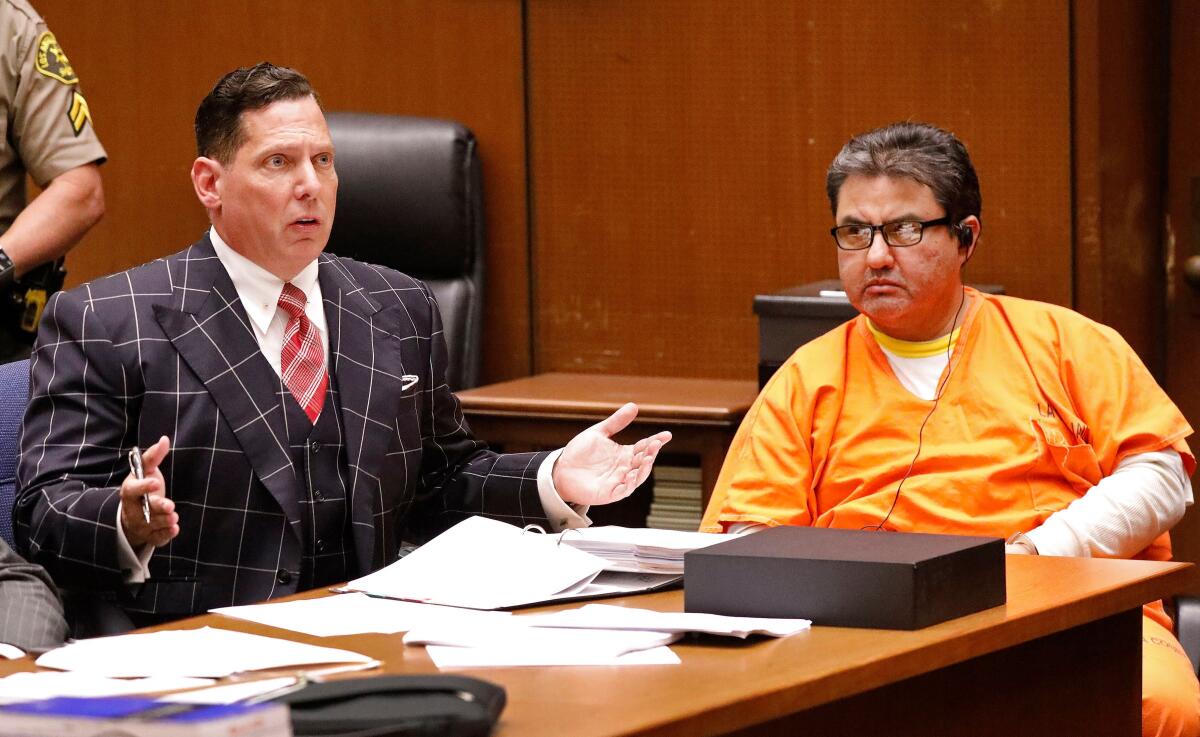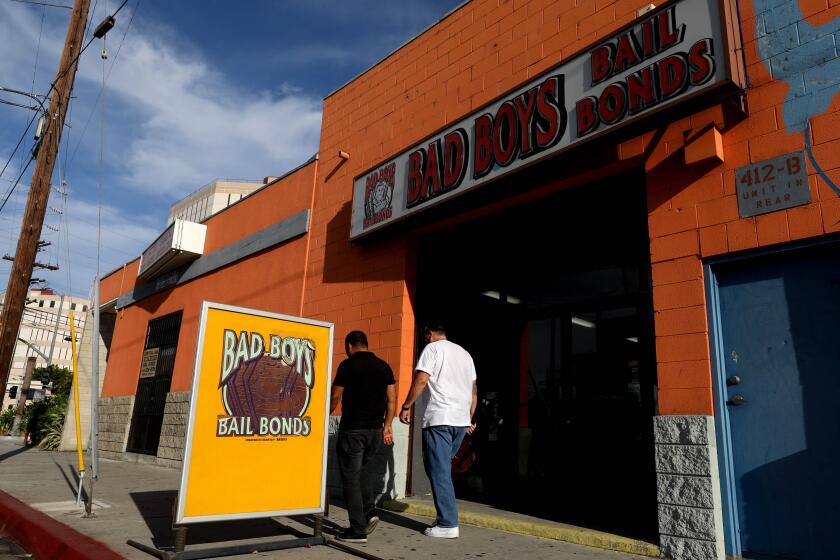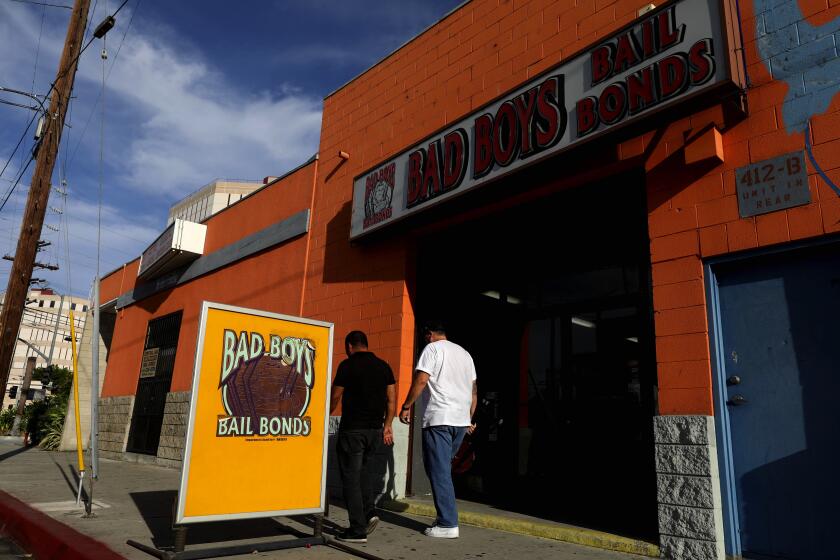Editorial: Bail’s purpose is freedom, not jail

- Share via
Megachurch leader Naasón Joaquín García was sentenced last week to nearly 17 years in state prison after pleading guilty to child sexual abuse, putting an end to a case that in its early days made headlines for the astonishingly high $50-million bail amount set by the court.
It may have been a California record in 2019. In 2017, bail was set at $35 million in San Mateo County for murder suspect Tiffany Li. The district attorney wanted the bar set even higher, because he was afraid Li might be able to post her bail and go free pending trial. And, in fact, she did.
When Garcia was arrested at Los Angeles International Airport in 2019, Xavier Becerra, California’s attorney general at the time, had the same worry. He wanted to be sure the leader of Mexico-based La Luz del Mundo church couldn’t raise enough from his many devoted followers to to post bail.
What was striking was that Becerra freely acknowledged his motivation.
“We have a great apprehension that Mr. Garcia will raise the money to get a bond to bail himself out,” Becerra said.
Bail was set at a stunning $25 million for Naason Joaquin Garcia after he was arrested last month at Los Angeles International Airport on charges of human trafficking and forcing children to perform sex acts.
Why not just ask for $1 billion? Or more? After all, a court in Texas set bail at $3 billion for murder suspect and bail jumper Robert Durst in 2004.
That amount was so excessive a Texas appeals court ruled it unconstitutional.
In fact, bail set at any amount a defendant can’t pay violates the Constitution. The refundable deposit is supposed to serve as an inducement for showing up at trial, not for keeping the defendant in jail.
It’s all too typical for judges and prosecutors to misuse bail to keep defendants locked up. Now many Americans have come to accept as normal and proper the shockingly un-American practice of punishment by incarceration before trial, regardless of the principle that the accused are to be presumed innocent until proven guilty.
Not everyone arrested and tried is guilty, despite prosecutors’ claims to the contrary. A jury acquitted Li, the woman who got out on $35-million bail.
So does that mean Garcia should have been able to bail out of jail while awaiting trial?
No. Pretrial release should be the norm, but there are rare exceptions, and Garcia was one of them. He was accused of horrendous acts of sexual abuse and trafficking against church members, including young children. He was facing many years in prison, and he had the means and motive to flee to Mexico. He could have easily evaded justice in the U.S. and continued a pattern of sexual abuse.
The conversation about bail reform should be about the role of money but instead keeps zeroing in on crime. Anti-reformers seem to like the confusion.
The proper response, given Garcia’s exceptional risk of fleeing, was to deny bail altogether, not to set it at such a ridiculously high level to burnish the tough-on-crime credentials of the prosecutor and the court.
In the end, the court dumped its $50-million bail and ordered Garcia held without bail pending trial. But when the case was refiled in 2020, bail was reinstated and set at a record of $90 million, even though Becerra’s office urged the court to again deny bail altogether.
In a twist of timing and politics, California’s entire money bail system was very nearly scrapped completely in the months before Garcia’s arrest. State Sen. Bob Hertzberg (D-Van Nuys) and then-Assemblyman Rob Bonta (D-Alameda) wrote Senate Bill 10 in 2018 to eliminate bail and replace it with a system of pretrial risk assessments. Release was to be automatic for low-level crimes, but subject to risk factors for more serious charges. Money was to play no role. Gov. Jerry Brown signed the bill into law.
But the bail bond industry blocked the legislation by gathering enough signatures for a voter referendum. In the campaign that followed, criminal justice reformers split, with some backing SB 10 and others joining with the bail firms in opposition, though on the entirely different argument that the new system would keep too many people locked up before trial and was racially biased.
In limiting courts’ ability to impose money bail, the state Supreme Court took a giant step toward justice
In November 2020, Californians defeated the referendum, known as Proposition 25. It’s impossible to know how many voters said “no” because they wanted to keep money bail or wrongly believed that voting “no” meant keeping the new law, given how confusingly California referendums are structured.
Last year, in People vs. Humphrey, the California Supreme Court ruled that imposing money bail may be acceptable for defendants who can pay it, but is unconstitutional for those who can’t. Defense lawyers say that many judges nevertheless continue to set impossibly high bail to keep defendants in jail before trial, in defiance of the Supreme Court. And some judges incorrectly deny bail even in cases in which pretrial release can be safely granted, if accompanied by sufficient monitoring or other conditions.
Unfortunately, the public seems to misunderstand the purpose of money bail, and the few prosecutors and judges who follow the law and the Constitution by respecting the presumption of innocence and releasing defendants before trial are too often unjustly attacked.
More to Read
A cure for the common opinion
Get thought-provoking perspectives with our weekly newsletter.
You may occasionally receive promotional content from the Los Angeles Times.













